2020~2017
2020
Publication of scientific paper on the stability of body temperature in whale sharks.

In collaboration with the Organization for Marine Science and Technology, Nagasaki University, and Atmosphere and Ocean Research Institute, the University of Tokyo, the body temperature stability of whale sharks has revealed by studying their behavior in the field.。
【Authors】Itsumi Nakamura,Rui Matsumoto, Katsufumi Sato(Bold letters: Staff members of Okinawa Churashima Foundation)
【Title】Body temperature stability observed in the whale sharks, the world’s largest fish.
【Journal】Journal of Experimental Biology
Discovery of a new species!The swallowtail monocle bream and the rosy dwarf monocle bream are almost identical. Fluorescence is the key to identification!

Okinawa Churashima Foundation and the research team from Field Museum of Natural History (Chicago) have together discovered a new species of dwarf monocle bream (Nemipteridae family). The new scientific species name is Parascolopsis akatamae and takes the common name rosy dwarf monocle bream.
It looks extremely similar to another species in Okinawan waters Parascolopsis eriomma which was redescribed and given the new common name of swallowtail dwarf monocle bream.
Until this study, these two species of dwarf monocle bream had not been differentiated. However, they were confirmed to be different species with DNA analysis.
There are also slight differences between the colors on their heads and the shapes of the tailfins. Additionally, the two species have different patterns of biofluorescence. When exposed to blue light, the rosy dwarf monocle bream Parascolopsis akatamae shows strong fluorescence from its isthmus and branchiostegal membrane. This is the world’s first case where the different patterns of fluorescence can be used to distinguish between similar fish species.
【Authors】Kei Miyamoto1、Caleb D. McMahan2、Atsushi Kaneko1
(1Okinawa Churashima Foundation)、(2Field Museum of Natural History)
【Title】Parascolopsis akatamae, a new species of dwarf monocle bream (Perciformes: Nemipteridae) from the Indo-West Pacific, with redescription of closely related species P. eriomma
【Journal】Zootaxa
A report of an individual humpback whale found in both Okinawa and Hokkaido published in the journal Honyurui Kagaku (Mammalian Science).

It is possible to identify individual humpback whales by the unique characteristics of their flukes. By matching photographs of flukes, the Churashima Foundation has been able to show that humpback whales migrate between Russia, Okinawa and the Philippines.
Paper published on the detection of environmental DNA (eDNA) from 291 fish species in coral reef seawater samples
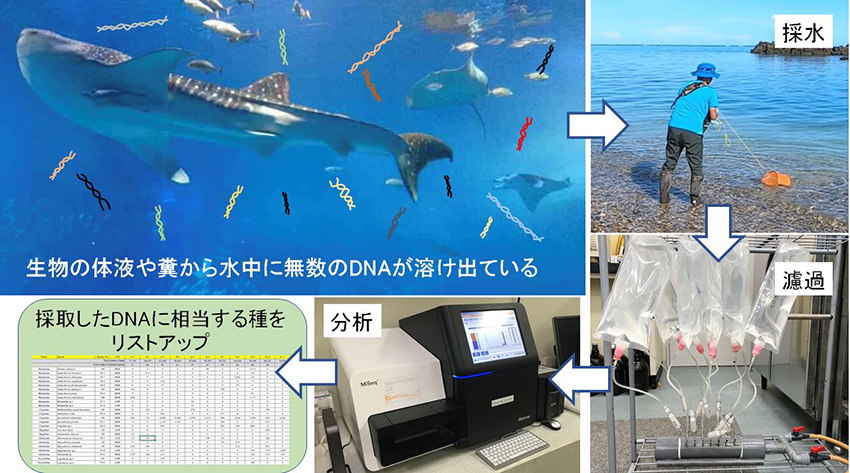
Okinawa Churashima Foundation Research Center in collaboration with the Natural History Museum and Institute, Chiba and a research team from the University of Hyogo have detected 291 fish species from 11 liters of seawater collected from 11 different places in the lagoon off the coast of Bise Village, Motobu, Okinawa. Metabarcoding was used to identify the environmental DNA (eDNA) of fish species contained in the seawater.
Releasing a green turtle after rehabilitation at Okinawa Churaumi Aquarium

On January 30th 2020, beach staff in Itoman City, Okinawa, found a stranded green turtle in a weak state. The turtle was rescued and brought to the Okinawa Churaumi Aquarium. At that time its carapace length was 36.4 centimeters and it weighed 4.7 kilos.
It’s like a mole?! Discovery of new behaviors in a species of sea pen.

A species of sea pen Sea pens are marine organisms in the phylum Cnidaria, class Anthozoa, and subclass Octocorollia.
Recording video images of the sea pen enabled the analysis of its movements that revealed many unreported behaviors. We successfully captured footage of it burrowing in the sand similar to a mole several times. Other species of Anthozoans use peristaltic movements to move on the surface of the sand, burrow up and down, and to clear off sediments that have accumulated on its body. However, this was the first time in the world to discover this particular behavior of moving within sand. The worm-like shape of the sea pen, lack of a solid axis, retractable polyps (autozooids) and its three-flanged sclerites are all physical traits that assist in this unusual mole-like behavior.
【Authors】 Yuka Kushida,Takuo Higashiji,James Davis Reimer (Bold letters: the Churashima Foundation Staff)
【Title】 First observation of mole-like burrowing behavior observed in a sea pen
【Journal】 Marine Biodiversity
Stools are held in until birth! Publication of scientific paper on fecal accumulation in stingray fetuses.
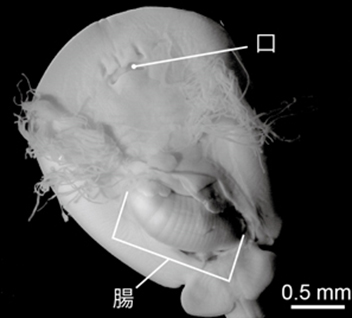
In mammals, the fetus grows in its mother’s uterus for months before it is born. This type of live-birth reproduction is called viviparity. If the fetus were to discharge feces while in the uterus, it would contaminate the amniotic fluid, and be detrimental to the growth of the fetus. In order to avoid this, a mammal fetus accumulates fecal matter within its body until birth.
Genetic evidence of interactions by whale sharks in Japanese waters with whale sharks around the world
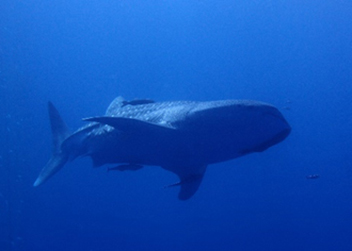
Whale sharks migrate long distances and are found across the world’s temperate and tropical zones. However, it was not clear what genetic interactions take place between those whale sharks found in Japanese waters and those in other parts of the world.
Publication of scientific paper on the relationship between pregnancy and white blood cells in female false killer whales

False killer whales are a species of small toothed whale widely distributed in warm waters around the world. Nine false killer whales are currently being reared at Okinawa Churaumi Aquarium.
Publication of scientific paper on the artificial insemination and hatching of giant oarfish
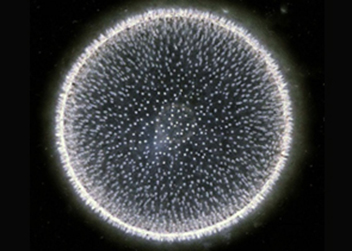
A scientific paper written by staff from the Okinawa Churashima Foundation Research Center was recently published in the journal Zoological Letters. The paper summarized the details of the world’s first successful artificial insemination and larval hatching of the mysterious and beautiful deep-sea fish the giant oarfish.
Publication of scientific paper on the reproductive ability of elderly Indo-Pacific bottlenose dolphins

Okinawa Churaumi Aquarium is the only place in Japan that rears the Indo-Pacific bottlenose dolphin. The Churashima Foundation has analyzed the reproductive capability of elderly male Indo-Pacific bottlenose dolphins (approximate age of 47 to 50 years). The staff monitored the levels of the hormone testosterone in blood samples, and the quality of the semen.
Publication of scientific paper on the stability of body temperature in whale sharks.
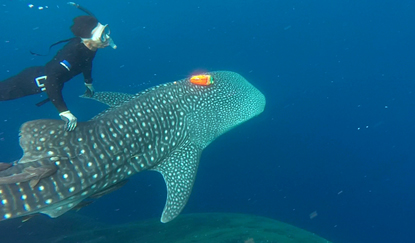
Okinawa Churashima Foundation in collaboration with the Organization for Marine Science and Technology, Nagasaki University, and Atmosphere and Ocean Research Institute, the University of Tokyo, the body temperature stability of whale sharks has revealed by studying their behavior in the field. The whale shark is known as the world's largest fish, with the largest being over 12 meters long and weighing dozens of tons. When the whale sharks were released into the wild, behavioral recorders and thermometers were attached to the sharks, and the behavior and changes in body temperature were measured for the first time in the world.When the temperature of the surrounding water changed due to vertical movements of several hundred meters, the body temperature of the whale sharks changed slowly, demonstrating the stability of the body temperature due to its large size.
The 2019 Okinawa Humpback Whale Conference: Sharing Knowledge about Dolphin and Whale Watching in Different Regions ? (Held at Okinawa Prefectural Museum and Art Museum)

On November 15th, 2019 (Friday), the 2019 Okinawa Humpback Whale Conference: Sharing Knowledge about Dolphin and Whale Watching in Different Regions was held at Okinawa Prefectural Museum and Art Museum.
Publication of scientific paper on the discovery of a new humpback whale breeding ground.
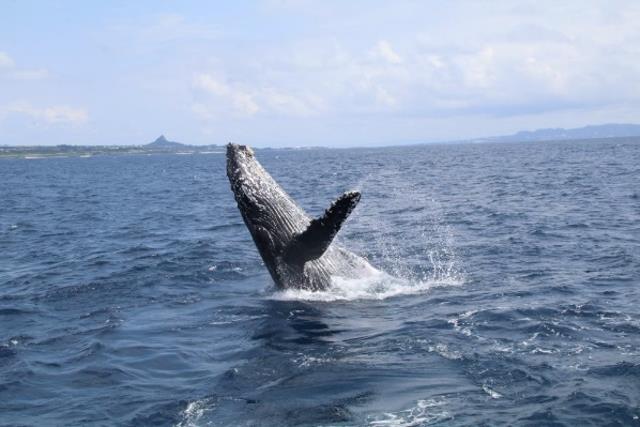
Humpback whales distributed in the western North Pacific Ocean are listed as an endangered species with limited information about their population size. For this research, joint surveys and studies were conducted on humpback whales in the same region by research groups from the National Oceanic and Atmospheric Administration (NOAA), University of Hawaii, Far Eastern Branch Russian Academy of Science, BALAYENA. ORG (Philippines), Ogasawara Whale Watching Association, Ogasawara Marine Center and Okinawa Churashima Foundation.
First record of the Propagurus haigae, pale-colored Propagurus hermit crab, in Japan discovered at a depth of 620 meters
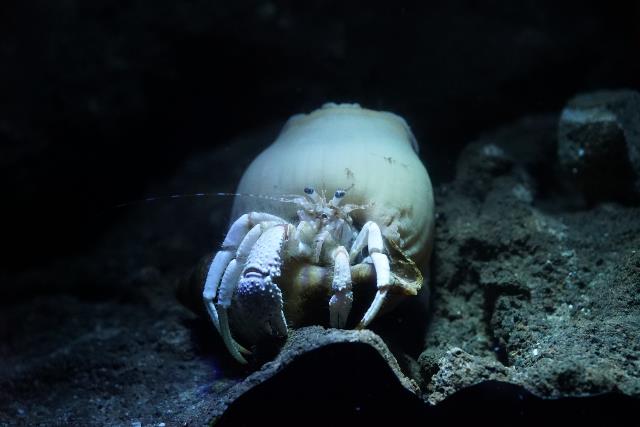
In May 2018, a research team from the Estuary Research Center, Shimane University and Okinawa Churaumi Aquarium collaborated to report that a Paguridae hermit crab collected off of Ie Island was Propagurus haigae a species that had not yet been found in Japan. Deep sea creatures are difficult to capture alive and through this discovery, it allowed us to determine its body colors whilst alive for the first time. This appearance of this species is similar to Pagurus hermit crabs but is paler in color. Its Japanese name was proposed as usuiro-nisehon-yadokari (pale-colored Propagurus hermit crab).
【Authors】Masayuki Osawa, Takuo Higashiji(Bold letters: Staff of Okinawa Churaumi Aquarium)
【Title】First record of Propagurus haigae (McLaughlin, 1997) (Decapoda, Anomura, Paguridae) from Japan.
【Journal】Crustaceana
Publication of a scientific paper describing the new species Eumunida balteipes
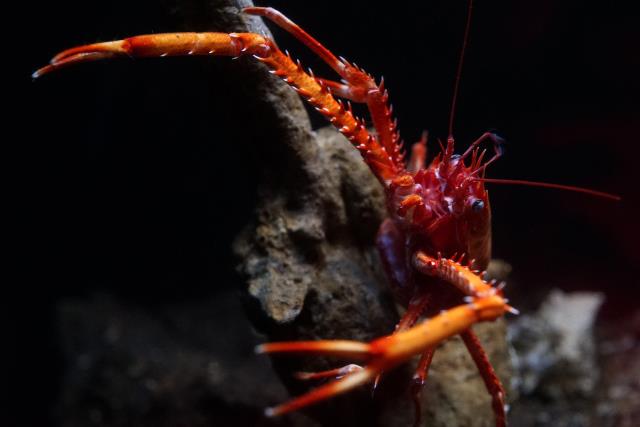
A deep-sea squat lobster that is displayed at Okinawa Churaumi Aquarium has been described as a new species. It was also given the Japanese name shimatsuno-koshioriebi. This species was found at a depth of 612 meters in the water intake pipe of The Okinawa Prefectural Deep Sea Water Research Institute on Kume Island, Okinawa. The lobster had been pumped up along with deep sea water. As a result of collaborative research between the Estuary Research Center Shimane University and Okinawa Churaumi Aquarium, it was recorded as a new species. The lobster has continued to be reared at the Okinawa Churaumi Aquarium for seven years and during this time we have learned aspects of its ecology such as eating habits and how it holds territories.
【Authors】Masayuki Osawa, Takuo Higashiji(Bold letters:Staff members of Okinawa Churaumi Aquarium)
【Title】Two large squat lobsters of the superfamily Chirostyloidea (Crustacea: Decapoda: Anomura) from the Ryukyu Islands, southwestern Japan, with description of a new species of the genus Eumunida Smith, 1883
【Journal】Zootaxa
Publication scientific paper describing the new species Synactinernus churaumi
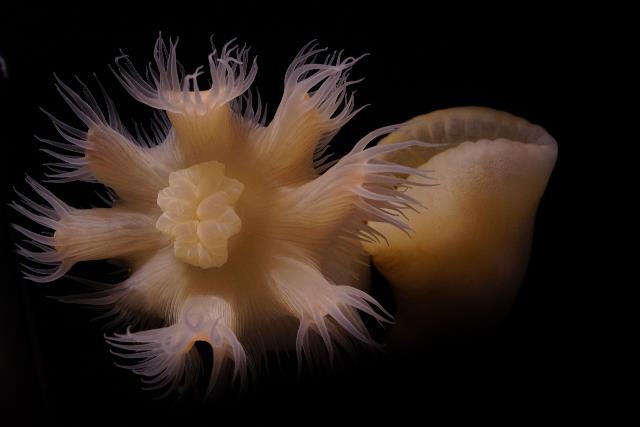
A deep-sea anemone being reared at the Okinawa Churaumi Aquarium has been described as a new species and named churaumi-kawari-ginchaku in Japanese. This species is in the same genus as the anemone Synactinernus flavus which was discovered 101 years ago and until now was thought to be the only species in its genus. Over a century later, this second species in the genus was discovered. This specimen was found offshore of Onna Village in Okinawa at a depth of 320 meters using Okinawa Churaumi Aquarium’s small remotely operated vehicle. Valuable footage of this anemone species living and forming colonies on the seabed and coral rocks was successfully recorded.
【Authors】Takato Izumi, Takuo Higashiji, Takuma Fujii, Kensuke Yanagi, Toshihiko Fujita(Bold letters:Staff members of Okinawa Churaumi Aquarium)
【Title】Redescription of Synactinernus flavus for the First Time After a Century and Description of Synactinernus churaumi sp. Nov.
【Journal】Zoological Science
Diadematid sea urchins Eremopyga denudata were found and recorded for the first time in the Ryukyu Archipelago.
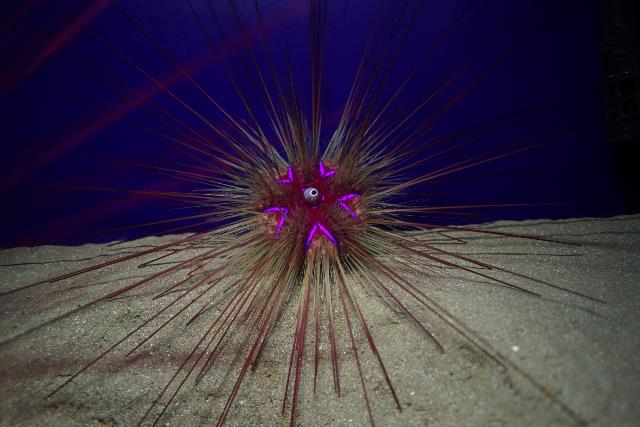
Diadematid sea urchins Eremopyga denudata were collected offshore of Okinawa’s Onna Village during a deep-sea organism survey conducted with a remotely operated vehicle by the Okinawa Churaumi Aquarium. This species does not yet have a Japanese name. It was the first record of this species in the Ryukyu Archipelago. This was achieved by a research team from The University of Tokyo, National Museum of Nature and Science, and the Okinawa Churaumi Aquarium. The sea urchin’s habitat, feeding habits, and even its symbiosis with the siphamia cardinalfish were confirmed for the first time. It lives at depths that sunlight does not reach, and therefore it’s proposed Japanese name is yamigangaze as yami is the Japanese for darkness.
【Authors】Hayate Tanaka, Takuo Higashiji, Toshihiko Fujita.(Bold letters: Staff of Okinawa Churaumi Aquarium)
【Title】Record of Eremopyga denudata (de Meijere, 1903) (Echinoida, Diadematoida, Diadematidae) from the Ryukyu Archipelago, Japan.
【Journal】Fauna Ryukyuana
Publication of a scientific papers on the sound production mechanism of coconut crabs

A research team from the Okinawa Churashima Foundation studying coconut crabs, the largest terrestrial crustacean, has revealed the variations of sounds produced by the coconut crabs and their sound producing system.
Publication of scientific paper on the first record of Larsonella pumilus in Japan
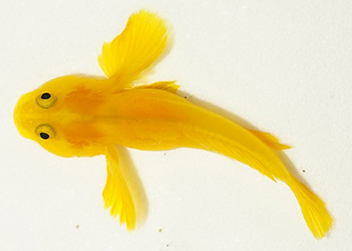
Research groups from the Okinawa Churashima Foundation and the Okinawa Institute of Science and Technology Graduate University (OIST) have made the first recording of the goby species Larsonella pumilus in Japan. It was found in a shell at a depth of 214 meters offshore of Seragaki in Onna Village, Okinawa and was recovered using a remotely operated vehicle. 。
Publication of scientific paper on photo-identification matching of humpback whales migrating between Russian waters and North Pacific.

Humpback whales are a large species of baleen whale. During summer they feed in high latitude waters off of Russia and Alaska. During winter, they breed and rear their calves in low latitude waters off of Okinawa and the Philippines.
Internal structure of the whale shark’s heart revealed
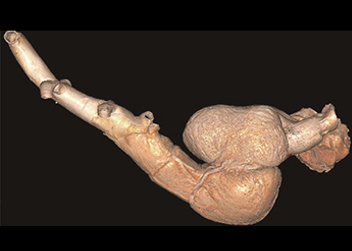
A heart works as a pump sending blood around the body. The structure of a particular animal’s heart is closely related to the physical abilities of that animal. In collaboration with Jikei University School of Medicine, the whale shark’s unique heart structure has been revealed by studying the heart’s internal structure.
Anthia species Plectranthias sheni recorded for the first time in Okinawan waters.
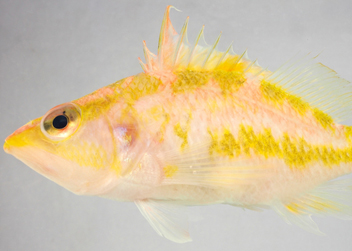
In 2017, research teams from Kagoshima University and Okinawa Churashima Foundation recorded Plectranthias sheni a species of Anthias in waters off of Yonaguni Island. This species of fish had not been found in Okinawa prefecture previously.
Publication of scientific paper on the foraging behavior of whale sharks using stable isotope analysis
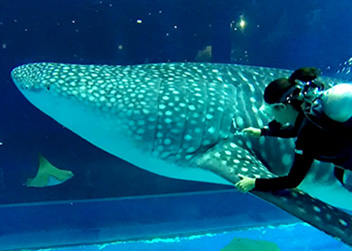
In order to determine how food is being digested and absorbed in the bodies of the whale sharks in Okinawa Churaumi Aquarium, we conducted stable isotope analysis of nitrogen and carbon in the skin, blood, feces and food.
Publication of scientific paper on the sexual maturation of a male whale shark
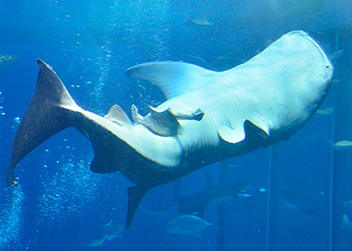
Through long term rearing of the whale shark “Jinta” at Okinawa Churaumi Aquarium, we have been able to discover the morphological and physiological changes that occur as a male whale shark reaches sexual maturation. This is a world’s first.
2019
Publication of a scientific paper on strandings and bycatch of humpback whales
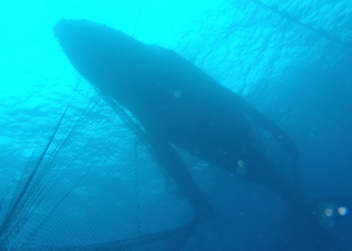
Based on previous surveys, Okinawa Churashima Foundation has conducted a study that searched for further details of strandings and bycatches of humpback whales.
Cleaning conducted on beaches where sea turtles lay their eggs
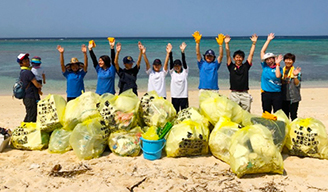
Okinawa Churaumi Aquarium, with the cooperation of local survey volunteers, is monitoring the number of egg-laying sea turtles on the beaches of the main island of Okinawa where the aquarium is located.
Conservation of rare freshwater fish: Fish ladder cleaning conducted at the Genka River

At the end of March, our staff volunteered to remove the sediment and driftwood that were causing the blockages and overflowing.
Research on the coconut crab broadcast on NETFLIX
The television show “72 Dangerous Animals - Asia!” is now broadcast worldwide on NETFLIX. The show was created by the Australian television production company Showrunner. Research by the Okinawa Churashima Foundation on the coconut crab is introduced in the second episode titled “Jaws and Claws”. We hope you enjoy the show.
A lecture on humpback whale research is available to watch on YouTube
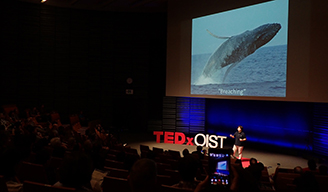
TEDxOIST was held at the Okinawa Institute of Science and Technology Graduate University (OIST). One of the lectures was given by a member of staff from the Okinawa Churashima Foundation who talked about her research into humpback whale ecology. The lecture can now be viewed on YouTube.
TEDx talks are broadcast online, and people from various parts of the world can come together to share their expertise. The event is conducted in the English.
2018
A world’s first! Successful captive breeding, producing a third generation of hawksbill sea turtles!
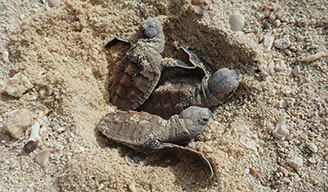
Okinawa Churaumi Aquarium has succeeded in being the world’s first aquarium to breed a third generation of hawksbill sea turtle.
Publication of a scientific paper on the captive delivery of a tiger shark

The pregnant tiger shark (upper) and its pups (lower)
Tiger sharks are large sharks that can grow to over 4 meters in length. Tiger sharks are one of the largest species of fish-eating shark living around Okinawa. In March 2017, a tiger shark at Okinawa Churaumi Aquarium gave birth to 30 pups.
There had been cases in the United States where fetuses from a deceased mother shark were taken from the womb and cared for in captivity. However, this was the world’s first natural delivery in captivity.
Through observation of the birth, we learned more about tiger shark reproduction such as delivery takes more than 3 hours, and all pups came out tail first.
Also, we observed an unusual behavior in the pups right after birth when they alternately swam then rested. This is thought to be equivalent to the crawling stage of a human baby where the pups are learning and improving their swimming skills.
Google Voyager story features the humpback whale surveys conducted by the Churashima Foundation
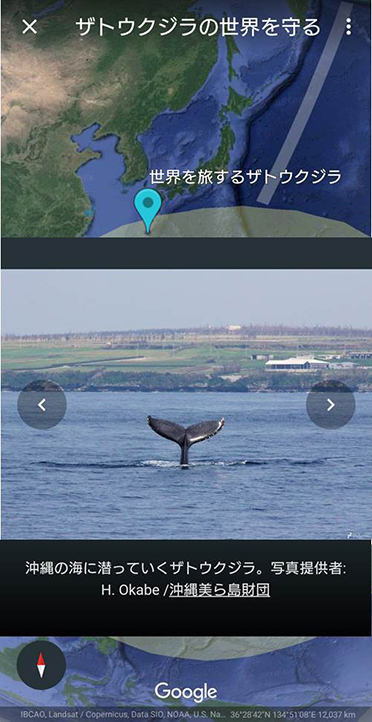
To mark World Ocean Day, June 8th 2018, the IUCN (International Union for Conservation of Nature) and Google LLC collaborated to produce “Sustaining the World of Humpback Whales” a Google Voyager story within Google Earth. The presentation featured the surveys of humpback whales conducted by the Churashima Foundation.
The purpose of the multimedia presentation is to spread the importance of conserving marine ecosystems through an education-centered promotion to the public. The webpage introduces how humpback whales migrate to different areas around the world. It shows their ecology and the surrounding marine ecologies and introduces the research institutes that conduct the surveys of humpback whales.
The migration of humpback whales to the waters of Okinawa and the research of Churashima Foundation Research Center are part of the presentation.
The Research Center will continue its efforts to research and survey the humpback whales, while cooperating with overseas research facilities in an effort to conserve humpback whales around the world.
Attachments: Photo posted from Google Voyager
2018 Okinawa Humpback Whale Conference
Whale watching experts give insights into how whale watching is conducted around the world.
Conference held at Okinawa Prefectural Museum and Art Museum
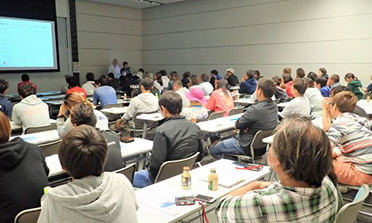
On December 7th Friday, 2018, whale watching experts gave insights into how whale watching is conducted around the world at a conference held at Okinawa Prefectural Museum and Art Museum.
The conference was held to share information acquired from cetacean research by the Churashima Foundation with whale watching operators and related parties from Okinawa and outside the prefecture. It also provided the opportunity to improve the information for whale watching tours. This was the sixth event of its kind, and Erich Hoyt, the leading researcher on whale watching industries (IUCN Marine Mammal Protected Areas Task Force: Important Marine Mammal Area Co-Chairman, Whale and Dolphin Conservation Society Senior Researcher GOBI, the Global Ocean Biodiversity Initiative) was invited to give a lecture on the current state of whale watching around the world and sustainability in the industry. The conference was attended by participants from all over Okinawa Main Island plus Zamami Island, Tokashiki Island, Amami Oshima, and it was evident that the whale watching industry was growing with each year. During the Q&A discussion section, many questions were asked on the contents of the conference. Attendees commented, “The subjects discussed at the conference have made us think about the future of whale watching and the policies of our business.” “We were able to reconfirm the importance of conservation awareness while running a sustainable business.” We aim to contribute to local tourism by enabling the exchange of opinions and gathering information.
2018 Okinawa Humpback whale conference Program・ Lecture summary
Embryo swims from one uterus to the other! Publication of a scientific paper on the embryonic behavior of a captive tawny nurse shark
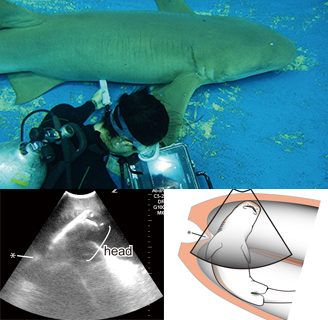
Similar to mammals, the offspring of some sharks grow in the maternal body. However, the mechanism underlying this phenomenon remains largely unknown. Particularly, the embryonic behavior of sharks within the uterus is hardly investigated.
The research group at Okinawa Churashima Foundation used the newly developed “underwater ultrasound” to observe the embryonic behavior of the tawny nurse shark inside the mother.
Our observation showed that the embryo is an active swimmer that sometimes migrates between the right and left uterus (unlike humans who have a single uterus, sharks have two uteri). Such highly active embryonic behavior has never been observed in live-bearing vertebrates.
Tawny nurse sharks have an unusual reproductive system. The embryo grows to a large size in the mother by feeding on sibling eggs. The high swimming ability of the embryo is possibly an adaptation for effectively searching these eggs.
Publication of a scientific paper on the long-distance movement of a hawksbill turtle from Okinawa to Indonesia
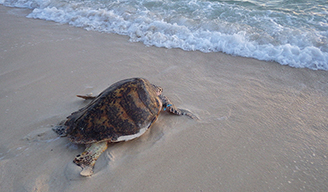
Hawksbill turtles live on coral reefs in tropical and subtopic regions. They are classified as critically endangered by the International Union for the Conservation of Nature (IUCN). It was known that the hawksbill turtles found in Okinawa have genetic similarities with hawksbill turtles in Indonesia and regions of East Asia, but there was no proof of their migration.
The Okinawa Churashima Foundation had rescued a weakened hawksbill turtle that was found near Okinawa. After its health and strength recovered researchers attached a tag and released it at Okinawa Expo Park beach on July 13th, 2016 (carapace length 74.9 cm, body weight 47.9 kg, male). On December 2nd, 2016, 142 days after its release, it was found at Yapen Island, Papua Provence, Indonesia, a straight-line distance of over 3,200 km. This was the first confirmation of long-distance migration in East Asia. Knowledge on the migration of hawksbill turtles is limited, therefore researchers expect to discover more information by continuing to tag and release turtles.
Publication of a scientific paper on the collection of the jellyfish Sanderia malayensis from the Ryukyu Archipelago, Okinawa.
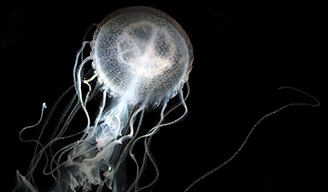
A scyphozoan jellyfish, Sanderia malayensis, was collected from the Ryukyu Archipelago, Okinawa. The umbrella of this species reaches 15 cm in diameter. Its tentacles and umbrella contain nematocysts. The Japanese name of this species is Amakusa kurage and is named after the Amakusa region where they are commonly found.
Sanderia malayensis is widely distributed in the subtropics and tropical regions of the Indo-Pacific. There were reports of its appearance in several parts of Japan, however there had been no reports of this species found in the Ryukyu Archipelago. This was the first discovery of Sanderia malayensis in the Ryukyu Archipelago, Okinawa.
Publication of a paper on the first Japanese record of a rare grenadier Coelorinchus sheni
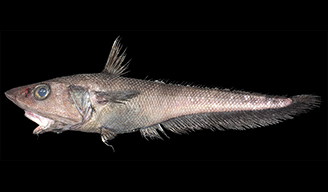
in 2016, a rare species of grenadier was collected in the waters near Ie Island, in Okinawa Prefecture. Teams from Kyoto University and the Okinawa Churashima Foundation reported that this was the first discovery of Coelorinchus sheni in Japanese waters.
Since it was first described as a new species in 2004, there had only been a dozen other individuals confirmed and it was considered a rare species only to been found around Taiwan. This large individual reaching nearly 70 cm was found and donated by a local fisherman to the Churashima Foundation. Its new Japanese name is proposed to be tora-hige due to tiger-like pattern on its back when young.
Link to journal
https://www.jstage.jst.go.jp/article/specdiv/23/1/23_230108/_pdf/-char/en
Publication of a scientific paper on the first Japanese record of the (Kawa-umihebi) Lamnostoma mindorum (Actinopterygii: Anguilliformes: Ophichthidae)
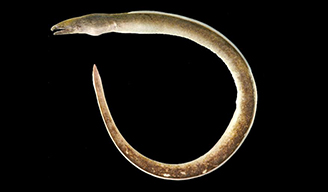
A parent and child visiting Okinawa from Kyoto Prefecture discovered an eel in a river in Nago City.
The Churashima Foundation Research Center’s animal research group confirmed the eel to be a Mindoro snake eel and this was the first time this species was recorded in Japan.
The proposal for the eel’s Japanese name is kawa-umihebi. This species of eel is rare, Okinawa is the sixth location where it has been discovered, and the northernmost. The findings of the research have been published in the academic journal Fauna Ryukyuana.
Implementation of artificial intelligence for coconut crab research
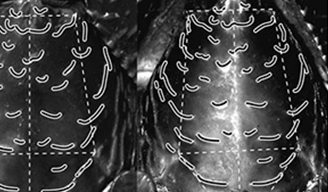
Researchers from the Churashima Foundation showed that individual identification of endangered coconut crabs is possible by studying the patterns on their shells. The ability to identify individuals has allowed many aspects of coconut crab ecology to be revealed. Monitoring of this species is continuing at Expo Park, and usually individual identification is determined by an expert through visual observation. To optimize this process the foundation has adopted artificial intelligence to compare and identify coconut crabs from photos of their shells.
Starting next year, we endeavor to approach this challenge from various angles to assure its accuracy. We expect this system to be widely used to monitor coconut crabs in the future.
Publication of Scientific Paper on the Successful Captive Breeding of Black Turtles
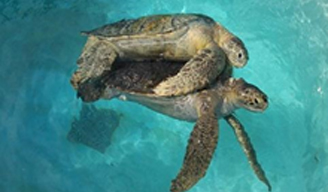
Black turtles are mainly found in the east of the Pacific Ocean around the Galapagos Islands. In Japan, they are found in the Ryukyu Islands including Okinawa. In 1999, Ocean Expo Park began rearing male and female black turtles in their Sea Turtle Pool. In June 2017, the black turtles mated successfully in captivity, a world’s first. Through this success, we were able to answers questions such as the size at which a female black turtle reaches sexual maturity, and the number of days required for egg formation. There is limited knowledge about the breeding ecology of the black turtle, and we expect to learn more through continued rearing and breeding.
Scientific papers published on the fluctuation of sex hormones and the reproduction state of zebra sharks.
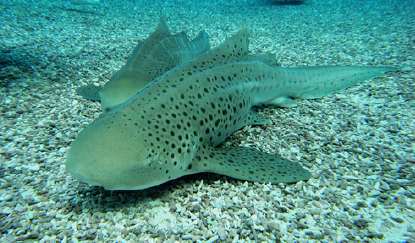
When undertaking the captive breeding of sharks and rays, selecting suitable individuals for breeding is important.
It is difficult to determine the reproduction state of females just by their appearance, therefore a test was needed.
For over a year, our foundation observed the reproductive organs of sexually mature female zebra sharks using ultrasound and measured the concentration of sex hormones in the blood. The results showed that the fluctuation of sextual hormones indicates the female’s reproduction state including egg development and spawning season. This shows that sex hormone fluctuations are a useful indicator of reproductive status. As zebra sharks and whale sharks are closely related, the results may also be useful for rearing and breeding of whale sharks in captivity.
Scientific paper published on development of the crescent-shaped caudal fin of the great white shark
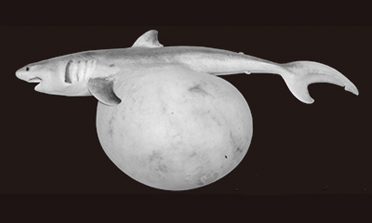
The great white shark has a vertically orientated crescent-shaped caudal fin. This shape of caudal fin is widely seen in fast-swimming fish such as tuna, and enables fish to efficiently swim long distances. The caudal fin of a great white shark is crescent-shaped since birth. It was thought that the crescent-shaped caudal fin formed within the womb, however the details of this were not clear.
We studied the embryos of over twenty great white sharks to study their development. At the early stage of development, the embryo’s caudal fin is sickle-shaped, it later changes to crescent-shaped. No other species of shark has such a significant change in the shape of their caudal fin, except the closely related salmon shark. This discovery may help us better understand the adaptations for fast swimming in great white sharks.
Links to journal
http://onlinelibrary.wiley.com/doi/10.1002/ar.23776/full
World’s first confirmation of sexual maturity in a Alfred manta ray, Mobula alfredi, by long-term monitoring!!
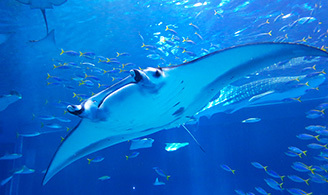
A male Alfred manta ray, born on June 17th 2008 and raised successfully at Churaumi Aquarium, was confirmed to reach sexual maturity.
Links to journal
https://bmczool.biomedcentral.com/articles/10.1186/s40850-017-0023-0
2017
The third generation of loggerhead turtle was born!
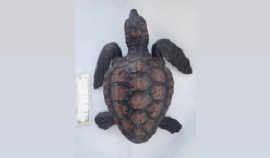
A third generation of loggerhead sea turtles successfully hatched at Ocean Expo Park’s sea turtle pool. 22 baby turtles hatched from eggs that were laid between May and June, 2017. The successful hatching was from eggs produced by a female loggerhead turtle that hatched at Expo Park’s sea turtle pool in 1995.
The Mammal Society of Japan Journalism Award received for scientific paper on the distribution of humpback whales around Okinawa
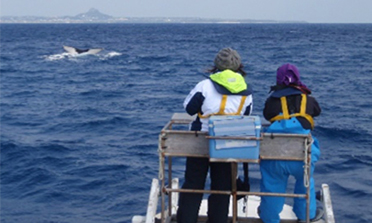
In 2017, the research group of the Okinawa Churashima Foundation in Motobu, Okinawa received a MSJ Journalism Award for their scientific paper published in the academic journal, Mammal Study. The paper is about the spatial distribution and habitat use patterns of humpback whales. It gives new details on humpback whales based on the results of research conducted into the distribution of humpback whales in the waters of Okinawa. 21 years of extensive data has provided valuable information. This is an important contribution to gaining ecological knowledge on large marine mammals that are difficult to observe, and helps review human activities such as whale watching. The award was given for these discoveries.
2017 Okinawa humpback whale conference
~Aiming for a sustainable whale watching industry~
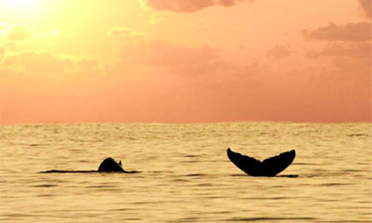
Humpback whales used to be caught for commercial whaling, and the number of humpback whales declined. After the ban on commercial whaling in the 1960s, the number of humpback whales has been increasing. The number of humpback whales that migrate to Okinawa is also increasing, and the Okinawan whale watching industry is thriving. In the midst of all of this, with the aim of a sustainable whale watching industry, it is necessary to understand the ecology of humpback whales, and to minimize any negative impacts of whale watching on the whales.
A baby false killer whale is born!
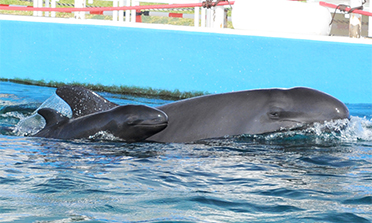
On Tuesday May 23rd at 8:15AM a baby false killer whale was born in the dolphin lagoon of Ocean Expo Park.
Scientific paper published on the mating behaviors of loggerhead turtles.
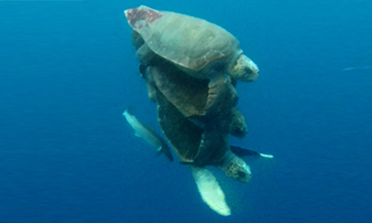
Some of the loggerhead turtles in the North Pacific lay their eggs on the Pacific side of Japan, centered on Yakushima Island. On the main island of Okinawa, loggerhead turtle egg laying has been recorded more than 1,000 times. However, there had not been any confirmed cases of mating in Japan, and information on where and when they mate was unknown. On March 21st, 2015, researchers from the Churashima Research Center were able to observe the mating behavior of loggerhead turtles in the west Pacific off of Okinawa Island’s Motobu Peninsula. An extremely rare mating behavior was recorded. Researchers observed two males mounting one female at the same time and further observed the response of the female, who was receptive to the courtship of a male. This observation suggests that the mating season of the Loggerhead turtle around Okinawa includes early spring.
Breeding success of captive black turtle!!
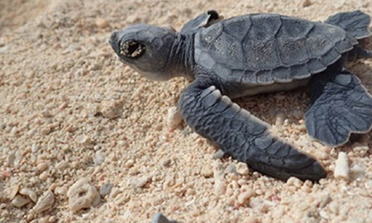
In August-October 2017, the first successful captive reproduction of the black turtle occurred at the Ocean Expo Park in Okinawa. The black turtle, a rare species in Japan, hatched at the park’s sea turtle pool.
How do the white shark embryos receive oxygen without placenta?
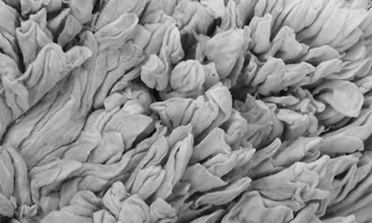
Most fish reproduce by laying eggs, however, many sharks nurture their fetuses in the womb (like mammals) and then give birth. Great white sharks are one of them. The fetus of a mammal is connected to the mother with an umbilical cord to supply oxygen. Sharks including the great white shark do not have an umbilical cord to supply oxygen to the fetuses. For many years, it has been a mystery as to how the fetuses receive oxygen.
This question has been answered by detailed examination of shark uteruses conducted by the Okinawa Churashima Foundation Research Center Animal Laboratory. According to their research the inner wall of the uterus of the great white shark is covered in fine protrusions that increase its surface area by around 60 times. It is estimated the oxygen exchange efficiency at the surface of the uterus is 250 to 400 times higher than other shark species, and is comparable to fish gills.
It is thought the uterus of great white sharks provides a good supply of oxygen and the fetus can absorb the oxygen that dissolves in the uterine fluid.
This means one more mystery concerning the reproduction mechanism of the great white sharks has been solved.
Scientific paper published on Okinawa’s rare freshwater fishes the Oriental weatherfish and Asian swamp eel.
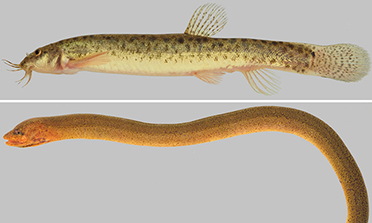
The Oriental weatherfish and the Asian swamp eel are freshwater fish that mainly inhabit paddy fields and swampy areas and are widely distributed in East Asia. Both species are also distributed in the Ryukyu Islands, and by being isolated from other areas their existence in Okinawa is considered a native population. However, both species are sharply declining due to the deterioration of their natural habitat, and there are concerns for their survival.
Since both species are also found as aquarium fish and as food items, non-native populations of the fish may be introduced, this leads to concerns over genetic contamination.
Both species were frequently seen in the channel flowing through the grounds of Okinawa Prefecture Hokubu Agricultural High School located in the northern part of Okinawa Island, but no academic surveys had been conducted. When the population density of both species was investigated with the collaboration of the Biological Research Department within the school, high densities of the species were found: 4.67 individuals/m² of Oriental weatherfish and 1.78 individuals/m² of Asian swamp eel.
Analysis of the DNA of collected individuals confirmed that all individuals belong to native populations, and therefore these are valuable populations which should be preserved. Working together with the school, conservation of this habitat is considered to be undertaken.

